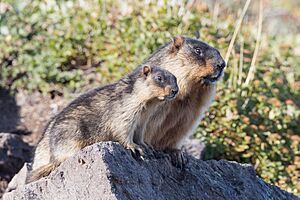Black-capped marmot facts for kids
Quick facts for kids Black-capped marmot |
|
|---|---|
 |
|
| Conservation status | |
| Scientific classification | |
| Genus: |
Marmota
|
| Species: |
camtschatica
|
The black-capped marmot (Marmota camtschatica) is a type of rodent that belongs to the squirrel family. These cool creatures live only in the Russian Far East. They are found in different areas, each with its own special group, called a subspecies. Black-capped marmots make their homes in cold places like arctic tundra and high mountains (alpine habitats). They can live from sea-level up to about 2,000 meters (6,500 feet) high! They also sleep for a very long time each year, usually 6 to 8 months, which is called hibernation.
Contents
What is a Black-Capped Marmot?
The black-capped marmot is a medium-sized marmot. Its body, not including the tail, is about 39.5 to 61.5 centimeters (15.5 to 24 inches) long. They usually weigh between 1.65 and 5.4 kilograms (3.6 to 11.9 pounds).
What Do They Look Like?
These marmots have a short tail. Their fur on their back is a mix of yellowish-grey colors. Their belly and chest are cinnamon or rusty brown. Their legs are a bit lighter in color, and their tail is brownish-black. A cool thing about them is the brownish-black fur on the top of their head. This dark color continues down their back as a stripe.
What Do Black-Capped Marmots Eat?
Black-capped marmots are herbivores, meaning they eat plants. Their diet mainly includes different kinds of grasses, herbs, and mosses.
How Do They Live Together?
Black-capped marmots are social animals. They live in groups called colonies. Each colony has many separate burrows, which are like underground homes. Inside each burrow, you'll find an adult male and female pair, along with their young. A mother marmot usually has five or six babies at a time. These young marmots stay with their family group for at least three years.
Hibernation Habits
When it's time to hibernate, many marmots from different burrows gather together. They make a special sleeping chamber deep underground. This chamber is filled with lots of soft bedding material. To stay safe and warm, they plug up the entrances to their burrows. Black-capped marmots hibernate from September all the way until mid-May. That's a long nap!
Daily Life of a Marmot
Black-capped marmots are active during the day. They don't move around much from their home area. They have to deal with very cold and harsh weather conditions throughout the year. The amount of daylight plays a big part in their daily activities. They are more active when the sun is out. To cool down when it's hot, they often lie on rocks or go into their burrows.
Marmots and Their Environment
These marmots also change the soil where they live. By digging burrows, hibernating, and moving around, they affect the plants in the Arctic tundra. The main part of their living area often has two larger rooms underground. This is where the family can hibernate together, and it's also where the female marmots usually give birth to their young.


